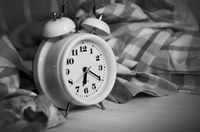Prairie Fare: 7 Tips to Catch Your ZZZZs
(Click an image below to view a high-resolution image that can be downloaded)
By Julie Garden-Robinson, Food and Nutrition Specialist
NDSU Extension
I leaned over and looked at my alarm clock.
I plopped my head back on my pillow. I did not need to be awake at 5 a.m. on a Sunday morning.
The previous evening, we had moved all the clocks back an hour to switch from Daylight Saving Time to Daylight Standard Time. In anticipation of the time change, I stayed up a little late because I would have an extra hour to sleep.
That didn’t work.
At 5 a.m., my body thought it was 6 a.m., my usual wake-up time. My brain was wide awake, but my body was unwilling to move.
I flipped over, closed my eyes and tried to make myself fall asleep.
That really didn’t work at all.
Eventually, I gave up and went downstairs, trying not to awaken the rest of my family or our dogs. I resisted taking a nap later in the day. However, by midafternoon, I was dragging because of my sleep deficit.
I stayed up a little late again that night. Unfortunately, the next morning, I woke up at 4:30 a.m. This was getting worse. Fortunately, by the third day, I had adjusted.
Adjusting to time changes usually takes one to two days.
We adults need seven to nine hours of sleep per night to function at our best. Too little sleep can have many effects on our health, including weakening our immunity. Long term lack of sleep can increase our risk for chronic diseases such as diabetes and heart disease. Too little sleep also can promote weight gain.
According to the latest guidance, adults ages 26 to 64 need seven to nine hours, and older adults (ages 65-plus) need seven to eight hours.
On the positive side, a couple of “catnaps” of 20 to 30 minutes in the morning and/or afternoon are OK, according to researchers.
If you have occasional sleep issues, you are not alone. At least 50 million Americans have some type of sleep disorder.
Consider these tips:
- Do your best to stick to a sleep schedule, even on weekends. If your sleep schedule has fallen outside of normal, make small changes. Maybe you are a night owl who usually goes to bed at midnight but you set a goal to go to sleep at 10:30 p.m. so you function better during the day. Try changing your bedtime by just 15 minutes a night.
- Be aware of what you eat and drink because some foods and beverages will rob you of shut-eye. We are all different in what our bodies tolerate. Having too much caffeine and alcohol can lead to nighttime restlessness for most people. Watch out for cola, chocolate and high-fat foods.
- Create comfortable sleeping quarters. A comfortable mattress and pillows are keys to good sleep. Be sure your bedroom is at the appropriate temperature: not too warm or too cold. A cooler room (between 60 and 67 degrees) helps promote snoozing. Babies and young children, however, may need slightly higher temperatures (65 to 70 degrees).
- Turn off the TV, cellphones or other personal electronic devices. Better yet: Plug your phone in an outlet in another room. Artificial light from all kinds of screens can affect our sleep. Many kids like to have constant contact with their friends on phones and iPads. Consider moving all screens out of their room to promote their well-being and ability to learn.
- Add some ambience to your sleeping quarters. Calm music, nature sounds or “white noise” works well for some people.
- Practice a relaxing bedtime ritual. Read a little while. If your mind goes into overload when you lie down to rest, make a list of things that you will take care of the next day. Then close your notebook and put aside your worries.
- Take some deep breaths. Breathe in for a count of three and exhale for a count of three. Do five sets of these breathing exercises. Focusing on your breathing can be very calming.
If you have ongoing issues with sleep, be sure to discuss them with your medical care provider to learn about potential treatments.
You can gather many more sleep tips at the National Sleep Foundation website (https://www.sleepfoundation.org/).
I like to enjoy a small cup of herbal tea, such as chamomile or lavender, before I go to bed. I find it to be a relaxing ritual. If you need a bedtime snack, try prepackaging 100-calorie snacks such as this recipe. Or have a small bowl of cereal and milk.
Do It Yourself Snack Mix
1 c. whole-grain cereal with fruit
1 c. Chex-type bran cereal
1 c. Cheerios
1/4 c. raisins or dried cranberries
1/4 c. peanuts
1/4 c. shredded coconut
Mix together. If desired, prepackage in sandwich bags. Makes eight (scant 1/2-cup) servings. Each serving has 110 calories, 4.5 grams (g) fat, 3 g protein, 17 g carbohydrate, 2 g fiber and 80 milligrams sodium.
(Julie Garden-Robinson, Ph.D., R.D., L.R.D., is a North Dakota State University Extension food and nutrition specialist and professor in the Department of Health, Nutrition and Exercise Sciences. Follow her on Twitter @jgardenrobinson)
NDSU Agriculture Communication - Nov. 7, 2019
| Source: | Julie Garden-Robinson, 701-231-7187, julie.garden-robinson@ndsu.edu |
|---|---|
| Editor: | Ellen Crawford, 701-231-5391, ellen.crawford@ndsu.edu |



